Can Cats Safely Enjoy Sweet Potatoes in Their Diet?
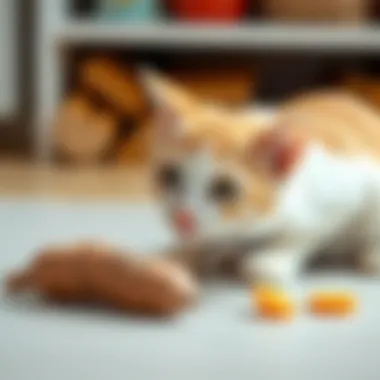
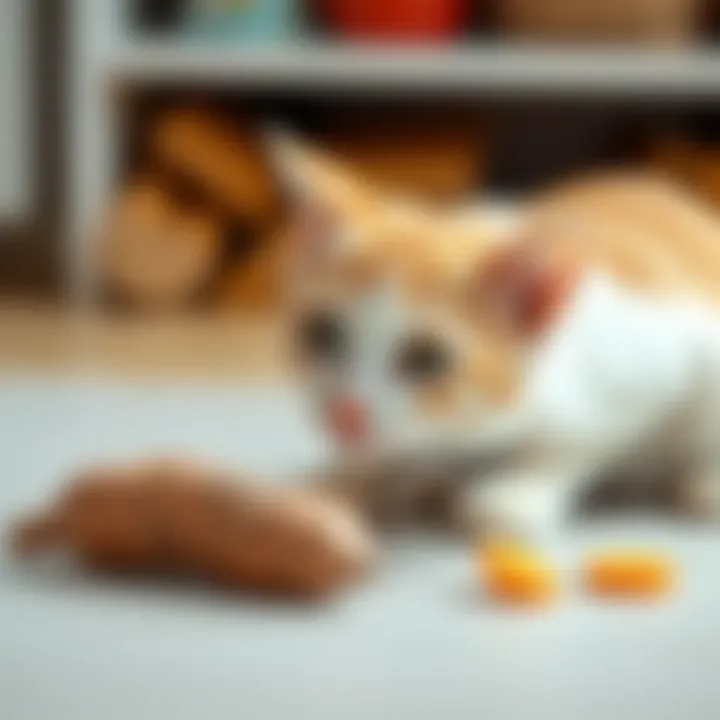
Intro
As a cat owner, you may have found yourself staring into your pantry, wondering if that sweet potato can be shared with your furry companion. Cats are notoriously picky eaters, and understanding their nutritional needs is paramount for their health. Sweet potatoes offer a package of vitamins and fibers, but the question remains — is it a safe addition to your cat's plate?
In this guide, we will sift through the nutritional aspects of sweet potatoes and assess their benefits and risks when it comes to feline diets. By the end, you’ll have a clearer picture that will help you make informed decisions regarding the inclusion of this vegetable in your pet's meals.
Health and Nutrition
Understanding Pet Nutrition
The essence of a cat’s diet lies in a balance between proteins, fats, and carbohydrates. Cats are obligate carnivores, meaning their bodies are crafted for meat consumption. However, some vegetables can complement their diet. Sweet potatoes, with their rich blend of vitamins A, C, and B6, along with manganese, may be beneficial in moderate amounts. But, it’s essential to remember that not all nutrition is created equal.
Common Health Issues by Species
Felines can encounter a slew of health issues, from obesity to diabetes, often linked to their dietary choices. An important note here is that sweet potatoes, while nutritious, have a medium glycemic index. This could lead to issues if taken in excess, especially for cats that are already prone to weight gain or have other metabolic concerns.
Preventive Care and Regular Check-Ups
Regular veterinary check-ups are a cornerstone of maintaining your cat's health. Discussing any planned dietary changes, such as introducing sweet potatoes, with your vet will ensure they're appropriate based on your pet's condition. It never hurts to have a professional weigh in.
Food and Dietary Advice
When contemplating sweet potatoes, consider the following:
- Preparation: Always cook sweet potatoes thoroughly. Raw sweet potatoes can be hard for cats to digest.
- Serving Size: Begin with small pieces as a treat rather than a meal staple.
- Allergy Check: As with any new food, monitor for any signs of allergies or intestinal upset.
Engaging Activities and Enrichment
Fun Games to Play with Your Pet
While nutrition is essential, engaging activities also play a crucial role in keeping your cat healthy. Simple games can help divert attention from hunger and keep their mind sharp. Things like feather wands or laser pointers can provide good exercise.
DIY Toys and Activities
Creating toys from everyday items can stimulate your cat’s curiosity. Think cardboard boxes or even paper bags; the possibilities are endless and budget-friendly.
Importance of Mental Stimulation
Training your cat to respond to cues or perform tricks can also be a fun way to enhance your bond. Mental exercise is as vital as physical, and it’s a terrific way to use up some of that pent-up energy.
Outdoor Adventures and Exploration
If your cat is open to it, supervised outdoor time can serve as enrichment, allowing them to encounter new sights and smells. Just ensure that they are safe and secure while exploring the great outdoors.
Resources and Community Engagement
Recommended Books and Websites
Several resources can provide more insight into feline nutrition:
- The Cat Bible: Covers everything from dietary needs to behaviors.
- Cornell University Feline Health Center: A reference for health-related information.
Forums and Groups for Pet Owners
Engaging with other cat owners can provide tips and insights. Websites like reddit.com/r/cats or Facebook Groups can serve as excellent places for community support and information sharing.
Finding Local Services and Classes
Look for local pet stores or veterinary clinics that offer classes about animal nutrition and care. They often have professionals who can clarify doubts and enhance your understanding of pet needs.
Encouraging Community Sharing and Contributions
Consider contributing back to the community by sharing your own experiences, especially if you try feeding sweet potatoes to your cat. Your insights could help other pet owners who are on the fence about the same topic.
Remember: Like any food, sweet potatoes can be part of a well-rounded diet when moderation is practiced. Always prioritize your pet’s specific needs and consult with a veterinarian if you have any doubts.
Prelude to Feline Nutrition
Feline nutrition serves as the backbone of a cat's health and well-being. Understanding what your cat needs nutritionally isn’t just a throwaway conversation; it’s essential for keeping your pet lively and happy. Cats are obligate carnivores, which means their diet is primarily based on meat. However, as pet owners, there's often a temptation to broaden their diet with various foods, including vegetables like sweet potatoes. Knowing what your cat requires and what they can safely consume is crucial.
Understanding Cat Dietary Needs
Felines have specific dietary needs that set them apart from many other animals. They thrive primarily on proteins and fats rather than carbs. This is because cats have evolved to obtain nutrients from animal tissues. A balanced diet should ideally contain high-quality proteins, essential fatty acids, amino acids, vitamins, and minerals.
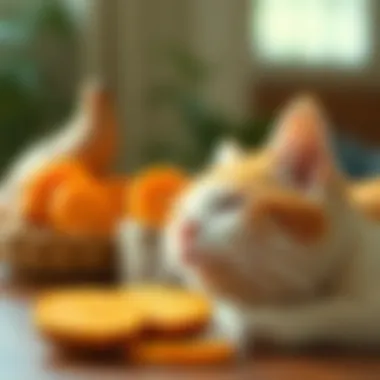
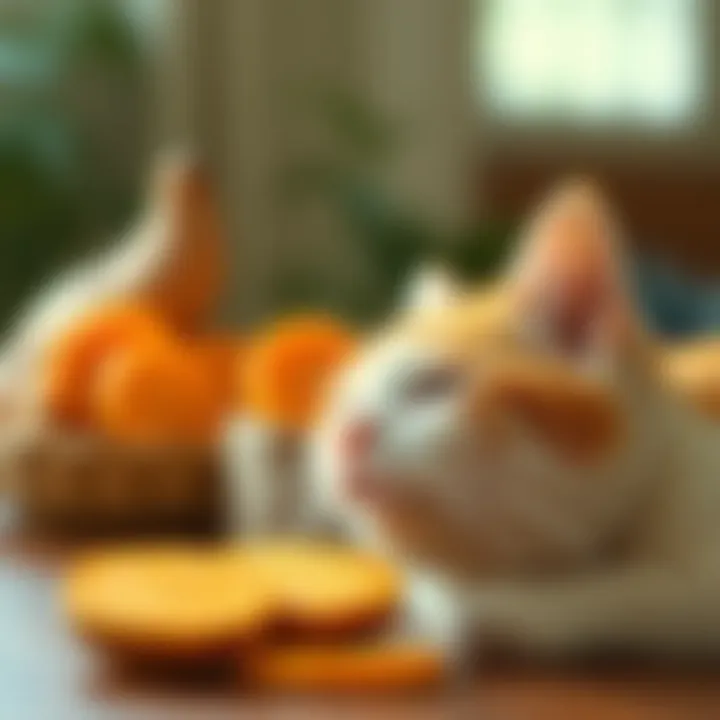
Feeding your cat a diet aligned with their natural requirements can help prevent health issues like obesity and diabetes, which are sadly common in housecats. You might think a little vegetable here and there wouldn't hurt, and while that could be true in moderation, it’s vital to tread carefully. For instance, some veggies can lead to digestive problems or other health concerns if not introduced properly.
Common Misconceptions About Feline Diets
Misunderstanding what cats can eat is more common than one might think, and it can lead to health risks. One prevalent myth is that all cats need a diet rich in grains or carbs. In reality, their digestive systems aren't built to handle large amounts of these substances, and they may not provide any significant health benefits.
Here are some typical myths debunked:
- Cats Love Milk: Contrary to popular belief, many cats are lactose intolerant, meaning dairy can upset their stomachs.
- Vegetables Are Great for Cats: While some cats can handle small amounts of cooked vegetables, they don't need them to thrive. Excessive vegetable intake can lead to digestive distress.
- All Meat Products Are Good: Some processed meats contain additives, preservatives, or harmful substances. Quality matters more than quantity.
By addressing these misconceptions, cat owners can better navigate feeding practices that suit their pets. With a well-informed approach, you can make dietary choices that keep your furry loved one feeling sprightly and healthy.
"What goes into your cat’s bowl matters. Ignorance isn't bliss when it comes to their diet."
In the following sections, we will delve deeper into the nutritional profile of sweet potatoes, their digestibility for cats, and whether they can be a beneficial addition to your pet's diet. With the right knowledge, you can ensure your feline friend has a diet that meets their unique needs.
Sweet Potatoes: A Nutritional Overview
Sweet potatoes have gained quite a reputation for their health benefits among humans. This section aims to explore whether those same virtues translate to our feline friends. Understanding the nutritional content of sweet potatoes can help pet owners make informed decisions about including this tuber in their cats' diets.
When it comes to discussing what our cats consume, it's not only about protein content or the occasional treat. It's about exploring options that provide nutritional variety while ensuring the ingredients in their bowls are safe and beneficial. Sweet potatoes, rich in carbohydrates, vitamins, and minerals, have become a topic of interest, sparking discussions about their role in feline nutrition.
Nutritional Profile of Sweet Potatoes
Sweet potatoes are a powerhouse of nutrition. Here’s a closer look at their composition:
- Vitamins: Rich in Vitamin A, C, and B6, sweet potatoes contribute to maintaining a healthy immune system and support eye health.
- Minerals: They contain vital minerals such as potassium and manganese, which are important for cellular function and metabolism.
- Fiber: Although cats naturally thrive on high-protein diets, the fiber in sweet potatoes can aid digestion. This aspect may be especially beneficial for older cats or those prone to constipation.
- Antioxidants: The vibrant orange hue of sweet potatoes comes from beta-carotene, an antioxidant that can help combat free radicals in the body.
For cat owners, understanding how these components work might bring comfort. However, while humans can derive many benefits from sweet potatoes, it’s crucial to navigate this topic with care when it comes to felines.
Health Benefits for Humans
While this article primarily focuses on cats, it's informative to shed light on why sweet potatoes are embraced so fervently by humans. Their health benefits provides a useful backdrop for understanding potential feline application:
- Weight Management: Due to their fiber content, sweet potatoes can create a sensation of fullness, making them popular for those looking to maintain a healthy weight.
- Blood Sugar Regulation: They have a low glycemic index, meaning they can help stabilize blood sugar levels—a key point for diabetic individuals.
- Heart Health: The potassium in sweet potatoes supports cardiovascular health by helping to regulate blood pressure, an important consideration for maintaining heart function.
- Anti-Inflammatory Properties: Sweet potatoes are known for their anti-inflammatory properties, beneficial for various health conditions.
In summary, while these advantages are striking, they shine a light on the conversation around incorporating sweet potatoes into a cat's diet. As always, it’s essential to consider the distinct nutritional needs of cats versus humans. What works wonderfully for one species might not resonate the same way for another.
Important Note: Always consult with a veterinarian before introducing new foods into a pet's diet, especially if they might cause digestive issues or allergies.
By laying out these nutritional facts about sweet potatoes, it becomes clearer why they are often thought of as a healthful food. Deciding if these tubers are suitable for your cat necessitates thorough consideration.
Can Cats Digest Sweet Potatoes?
Understanding whether cats can digest sweet potatoes sheds light on how this vegetable fits into their unique dietary requirements. It’s not just about whether they can nibble a bite now and then; it’s about how their bodies process different foods. Additionally, examining the digestibility of sweet potatoes can help pet owners make informed decisions regarding their feline’s nutrition, ensuring pets stay healthy while nibbling on something new.
Feline Digestive System Basics
Cats are obligate carnivores, which means their natural diet consists mainly of meat. Their digestive system is quite different from that of omnivores like humans. Cats rely on specific enzymes to break down protein rather than carbohydrates.
When it comes to digestion, felines have a shorter gastrointestinal tract, allowing them to efficiently absorb nutrients from protein sources. This lack of a complex system for breaking down plant matter poses some questions about how well cats can handle sweet potatoes.
- The Stomach’s Role: A cat's stomach is designed to process meat, making it highly acidic. This acidity helps in breaking down proteins, but plants, like sweet potatoes, require different digestive processes that cats aren't fully equipped for.
- Intestinal Absorption: Once food reaches the intestines, absorption takes center stage. While some cats can handle small amounts of fiber from veggies like sweet potatoes, they may not extract all the nutrients effectively. Cats generally benefit more from animal-based nutrients than those found in plant sources.
This biological backdrop is critical when considering sweet potatoes. They can be a source of vitamins and fiber, but cats may not gain as much nutrition from them compared to their usual diet.
Comparison with Other Vegetables
When putting sweet potatoes under the microscope, it's wise to weigh them against other vegetables that are often considered cat-friendly. While sweet potatoes have some healthy qualities, there are other options that might suit a cat’s system better.
- Carrots: Rich in beta-carotene and easier for some cats to digest. Carrots can be offered in small amounts either raw or cooked and some cats may accept them better.
- Pumpkin: A popular dietary addition for many pets, pumpkin is not only high in fiber but also well known to aid digestion and soothe upset stomachs. Many cats tend to enjoy its texture, making it a favorite for pet owners.
- Green Beans: Often used as a low-calorie treat, green beans provide fiber without the complexity of digestion that sweet potatoes present. They can help with weight management and promote healthy digestion since many cats can tolerate them well.
Potential Benefits of Sweet Potatoes for Cats
Understanding the potential benefits of sweet potatoes for cats is crucial in determining how these tubers can fit into a feline diet. While cats are obligate carnivores, their digestive systems can sometimes process certain plant-based foods. Sweet potatoes, in particular, offer nutritional advantages that may positively impact your cat's health, alongside the importance of moderation in any dietary changes.
Source of Fiber
Sweet potatoes serve as an excellent source of dietary fiber. Fiber plays a significant role in feline digestion, primarily aiding in maintaining a healthy digestive tract. It helps prevent constipation and promotes regular bowel movements, which can be particularly beneficial for cats that might experience digestive slowdowns.
Felines are notorious for having sensitive stomachs. Introducing sweet potatoes into their diets can help introduce a gentle source of fiber. However, it is important to remember that cats typically require much less fiber than dogs or humans. In small amounts, sweet potatoes can support gut health without overwhelming a cat's digestive system.
"Too much fiber in a cat's diet can lead to digestive upset. A small portion of well-prepared sweet potato is often enough to see benefits."
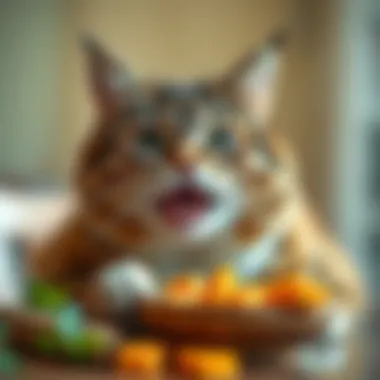
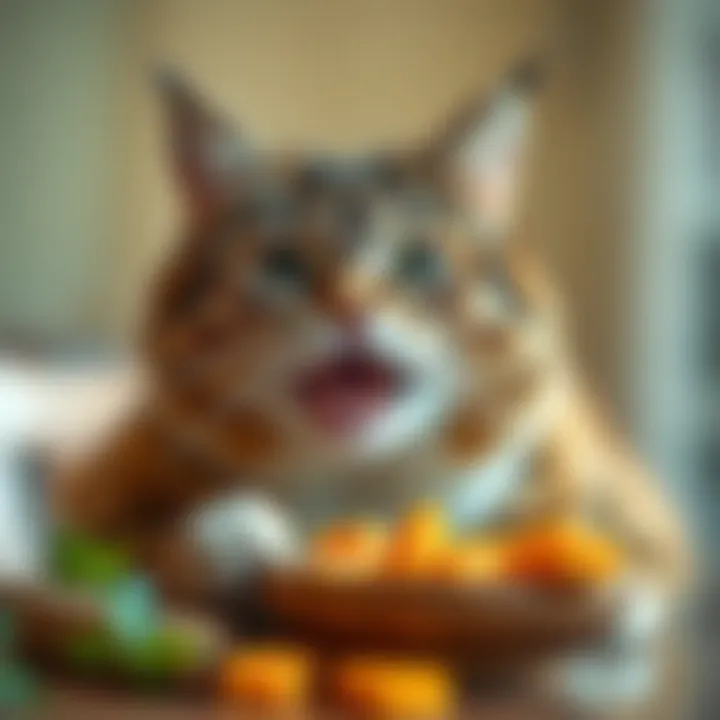
When planning to add sweet potatoes, a common approach involves pureeing or cooking them without added salt or spices. This not only makes the sweet potatoes easier to digest but also helps to amplify their fiber content. As you prepare to introduce this new food, keeping an eye on your cat's stool and overall behavior can give you an indication of how well they are adjusting.
Vitamins and Minerals
Another remarkable aspect of sweet potatoes is their rich nutritional profile. They are loaded with vitamins and minerals that can complement your cat's health when offered in moderation. For instance, sweet potatoes are a rich source of Vitamin A, critical for maintaining good vision, immune function, and skin health. This vitamin is an antioxidant and thus helps combat oxidative stress, which can lead to health issues in cats as they age.
In addition to Vitamin A, you can also find Vitamin C, potassium, and manganese in sweet potatoes. Each of these micronutrients plays a distinct role in your cat's health. Potassium, for example, helps regulate fluid balance and muscle function. Additionally, manganese supports bone health and metabolism.
In summary, while sweet potatoes are not a necessary part of a cat's diet, their inclusion can provide additional nutrients and benefits. However, always consider your individual cat's health status and dietary needs before making changes. Incorporating small amounts of sweet potatoes, packed with fiber, vitamins, and minerals, can be an enriching addition.
By being informed about these benefits, cat owners can make educated decisions that contribute to their pets' well-being.
Risks and Concerns Associated with Sweet Potatoes
When considering the introduction of sweet potatoes into your cat's diet, it’s essential to examine the potential risks and concerns that can arise. Just because a food is healthy for humans doesn’t automatically make it a suitable option for our furry companions. Sweet potatoes can offer some benefits, but they can also pose certain challenges that cat owners need to be aware of.
Digestive Issues
Cats are obligate carnivores, meaning their bodies are adapted to digesting primarily meat. Their digestive systems are not well-equipped to handle large amounts of plant material. While sweet potatoes are packed with fiber, a sudden introduction to this high-fiber food may lead to digestive upset.
If you feed your cat too much sweet potato, it can result in:
- Diarrhea: An upset stomach may lead your cat to have loose stools, which can cause dehydration if it persists.
- Gas and Bloating: A gassy cat is not only uncomfortable but can also be a cause for concern. This discomfort can be quite distressing to your pet.
- Nausea: You might notice your cat displaying signs of nausea, such as vomiting.
To mitigate these risks, it's crucial to introduce sweet potatoes slowly, allowing your cat's system to adapt gradually.
Potential Allergies
Cats can develop allergies or sensitivities to various foods, and sweet potatoes are no exception. Even though it is categorized as safe for cats, some may exhibit an adverse reaction. Keep an eye out for:
- Itching or Scratching: Excessive grooming or scratching can be a sign of an allergic reaction.
- Red or Inflamed Skin: Observe the skin for any signs of irritation.
- Digestive Distress: Reactions may manifest as vomiting or diarrhea, similar to other digestive issues.
If your cat shows any of these symptoms, it’s advisable to discontinue feeding sweet potatoes and consult with a veterinarian for guidance.
Preparation and Serving Size
Proper preparation and portioning of sweet potatoes are critical to ensuring the safety of your pet. Cats should never eat raw sweet potatoes, as they can be difficult for them to digest. Instead:
- Cook Thoroughly: Boiling or baking sweet potatoes until soft ensures that the starches are broken down, making them easier on your cat's tummy.
- Avoid Seasoning: Many spices and additives we commonly use in cooking can be harmful to cats. A plain serving is best.
- Serve in Moderation: A small bite or two is sufficient. Generally, a teaspoon of cooked sweet potato mixed with regular food can be a safe serving size. Larger portions may overwhelm their digestive system.
By adhering to these preparation methods and serving sizes, you can minimize potential health risks while exploring the possibility of adding sweet potatoes to your cat's menu.
"While sweet potatoes can be a fun addition to a feline diet, moderation is key. Always prioritize your cat's health over trying new things."
Ultimately, being mindful of these risks and concerns enables pet owners to make informed decisions regarding their cats’ diets, ensuring that any new food like sweet potatoes enriches, rather than harms, their health.
Comparative Analysis: Sweet Potatoes vs. Other Cat-Friendly Foods
When it comes to feeding our feline companions, we often find ourselves wondering not just what foods are safe, but also which ones provide the greatest benefits. This section will explore how sweet potatoes stack up against other cat-friendly options like carrots, pumpkin, and green beans. It’s essential to know the nutritional merits and potential drawbacks of these foods to make informed decisions for our cats' diets.
Carrots
Carrots are not just a crunchy snack for us; they bring a bundle of vitamins to the table for our cats, too. Full of beta-carotene, they can contribute to eye health and support overall immunity. However, being high in sugar compared to other vegetables, they should be given sparingly. Unlike sweet potatoes, carrots can be a bit tough for cats to digest in their raw form. Some pet owners might prefer to cook them lightly to make them easier to chew and digest.
Benefits of carrots include:
- Low Calories: Great for cats needing to manage weight.
- Fiber Content: Helps maintain gut health.
But it's crucial to avoid the temptation of overindulging, as too many carrots may lead to stomach upset. So, while carrots can be a nutritious option, moderation is key.
Pumpkin
Next on the list is pumpkin, a winter staple that also finds its way into cat diets. Its high fiber content makes it an ideal option for digestive health, especially for cats experiencing constipation or diarrhea. Pumpkin is soft and much easier for cats to digest than many other vegetables, making it a favorite among pet owners. Sweet potatoes and pumpkin both boast similar nutritional benefits, but pumpkin tends to be lower in calories and carbs, making it an appealing choice for cats needing a little help in the bathroom!
Key points about pumpkin:
- Rich in Vitamins: Particularly vitamin A, vital for vital body functions.
- Hydrating: Contains a good amount of water, aiding in hydration.
Pumpkin is often praised by veterinarians for its benefits, and many cats enjoy the taste, making it a win-win.
Green Beans
Let’s not forget green beans, a curious addition to many feline diets that often surprises cat owners. Rich in vitamins and low in calories, these vegetables are a wonderful way to supplement your cat's meals or use them as treats. They can serve as a crunchy delight that provides essential nutrients and a necessary change from their typical fare.
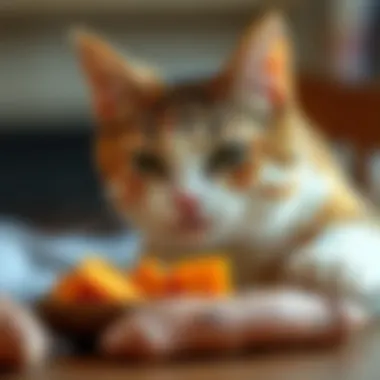
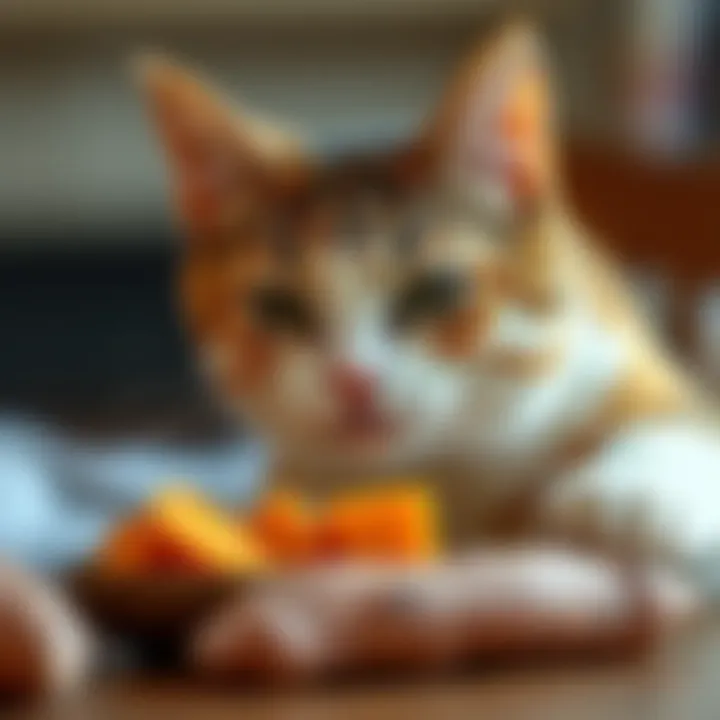
Green beans can also assist in maintaining a healthy weight due to their high fiber and low calorie content. When cooked, they become softer and easier for cats to chew—similar to how we might prepare them for our meals.
Considerations for green beans include:
- Fiber Boost: Helps promote healthy bowel movements.
- Filling: Keeps cats feeling full with fewer calories.
However, they are not a direct substitute for a balanced animal protein diet—cats are obligate carnivores and their protein needs must come first.
Overall, when weighing sweet potatoes against alternatives like carrots, pumpkin, and green beans, it becomes evident that each offers unique benefits and limitations. Incorporating a variety of these foods—with sweet potatoes in moderation—can create a more diverse and nutritious diet for your feline client.
Expert Opinions on Sweet Potatoes for Cats
When it comes to feline nutrition, expert insights provide a valuable lens through which cat owners can navigate what to feed their beloved pets. The subject of whether cats can eat sweet potatoes is becoming increasingly relevant as more pet owners look for holistic, healthy alternatives to traditional cat food. Understanding the opinions of veterinarians and nutritionists helps illuminate the benefits and potential pitfalls of adding sweet potatoes to a cat's diet.
Veterinary Insights
Veterinarians play a crucial role in shaping our understanding of what foods are suitable for cats. Their insights often stem from clinical experience, research, and a deep understanding of feline physiology. Most vets agree that while cats are obligate carnivores, meaning their diet should mostly consist of meat, incorporating small amounts of plant-based foods like sweet potatoes can offer some benefits.
Cats can potentially derive certain vitamins and minerals from cooked sweet potatoes. These tubers are rich in vitamins A, C, and E, as well as antioxidants, which may support overall health when fed in moderation. However, vets usually stress that the primary component of a cat’s diet should remain high-quality animal protein.
Some veterinarians caution against introducing sweet potatoes without thorough consideration, especially if a cat has any underlying health conditions or if they've never been exposed to them before. The risk of gastrointestinal issues such as diarrhea can increase if sweet potatoes are introduced too quickly or in large portions. Regular veterinary check-ups can help monitor how well a cat tolerates new foods like sweet potatoes and adjust dietary plans as needed.
"Always consult your veterinarian before making significant changes to your pet's diet. It's essential to find what works best for your unique feline friend."
Nutritionist Perspectives
Pet nutritionists provide a specialized viewpoint on the dietary inclusion of sweet potatoes in cat diets. They focus more on the nutritional aspects and how these tubers can fit within a balanced meal plan. Many nutritionists recognize that sweet potatoes are not inherently harmful, offering dietary fiber that can aid digestion and promote a feeling of fullness in cats. However, these benefits come with caveats; they emphasize that any supplementation should not overshadow the essential nutrient requirements that come from animal proteins.
Nutritionists typically suggest considering the overall caloric intake of the cat when introducing sweets potatoes. They advocate for a careful balance, recommending that sweet potatoes should not exceed a small percentage of the total dietary intake. In practice, this might translate to a small spoonful or two as an occasional treat rather than a staple.
Moreover, nutritionists also highlight the necessity of preparing sweet potatoes correctly—cooked and mashed, for instance—to make them easier for cats to digest. Ensuring that sweet potatoes are served plain, without added spices or sauces, is also crucial as these can upset a cat's delicate digestive system.
In summary, the consensus among veterinarians and nutritionists is that while sweet potatoes can be offered to cats, doing so should be done thoughtfully and in moderation, respecting the unique dietary needs of each individual feline.
How to Introduce Sweet Potatoes to Your Cat
When it comes to incorporating new foods into a feline's diet, patience and care are paramount. Sweet potatoes, while often lauded for their health benefits, pose a unique challenge when considering the preferences and systems of our beloved cats. For cat owners aiming to enhance their pets’ nutrition, understanding how to introduce sweet potatoes carefully can lead to a more enjoyable and beneficial experience for both the pet and the owner.
Starting with Small Portions
Starting small is like tiptoeing into a pool to check the water temperature, especially when it involves introducing sweet potatoes into a cat's diet. It is crucial to begin with minuscule amounts—perhaps just a quarter of a teaspoon of cooked and mashed sweet potato. This initial portion allows you to gauge how the cat reacts without overwhelming their delicate digestive system.
Why is this small portion so important? Introducing too much too soon could lead to upset stomachs or unwanted digestive discomfort. Besides, a cat’s natural inclination is to be wary of new foods, and a gradual approach can help them adjust without second-guessing their favorite dishes. Gradually, as you observe that your cat enjoys this new addition without adverse reactions, you can slowly increase the serving size. However, any increase should remain modest.
To properly prepare the sweet potato, ensure it’s thoroughly cooked—boiled or baked—and mashed without any additional seasonings or ingredients. Sweet potatoes, in their natural state, are already packed with flavors that can entice a curious feline taste bud. Thus, it’s wise to keep things simple initially.
Monitoring Reactions
After you’ve offered the initial taste, the next steps involve close observation. Think of yourself as a detective, looking for clues that will reveal your cat's response. Monitoring reactions might include paying attention to their mood, litter box habits, and overall health.
Some signs to look for include:
- Positive Response: If your cat shows interest or devours the small portion with glee, that’s a good sign.
- Disinterest: If they walk away or sniff at it disapprovingly, you may want to reconsider or try again later.
- Digestion: Watch for any signs of gastrointestinal distress, such as vomiting or changes in stool consistency in the days following their sweet potato tasting.
Maintaining a food diary can be beneficial as you track your cat’s reactions over time. This could include notes on any themes in behavior related to the introduction of sweet potatoes—good or bad. Keeping an eye on food patterns can immensely help when seeking to make definitive decisions about what works for your pet. Evaluating their overall health as well can also ensure that sweet potatoes fit harmoniously into their diet.
In summary, introducing sweet potatoes to your cat’s diet requires you to tread carefully, like navigating an unfamiliar path. You want to ensure your cat's safety, comfort, and enjoyment while potentially enriching their meals with nutritious variety.
Always consult with your veterinarian before making significant changes to your cat's diet, as they can provide tailored advice based on your specific pet's health needs.
For more insights into pet nutrition, visit resources like AVMA or The Cat Fanciers' Association.
The End
As we reach the end of this exploration into whether our beloved felines can share their meals with sweet potatoes, it’s important to stitch together the threads that we’ve unraveled. This discussion goes beyond just a simple yes or no; it delves into the intricate realities of feline nutrition and the role sweet potatoes may or may not play in our cats’ diets.
Summarizing the Key Points
Throughout the article, we established that sweet potatoes are not inherently harmful to cats, but moderation stands as a pivotal theme. Here are the essential takeaways:
- Nutritional Value: Sweet potatoes are rich in fiber, vitamins, and minerals, offering some health benefits that can positively affect a cat's digestive health and overall well-being.
- Digestive Considerations: Though cats can digest certain carbohydrates, their primary diet should revolve around proteins and fats. Sweet potatoes may be palatable for most cats, but their gastrointestinal systems are not designed for high fiber intake.
- Health Risks: Always keep an eye out for potential allergies or digestive upset when introducing any new food. Sweet potatoes may cause issues if overfed or if a particular cat has sensitivity to them.
- Preparation Matters: The method of preparation is crucial. Raw sweet potatoes are indigestible and potentially harmful. Cooking them is necessary to make them safe for consumption.
In summary, while sweet potatoes can be a healthier treat for your pet, they should not replace the core components of a high-protein cat diet.
Final Recommendations for Cat Owners
For cat owners considering sweet potatoes as a dietary option for their pets, here are some actionable tips:
- Start Slow: Only introduce small, cooked portions into your cat's meal to gauge their reaction.
- Watch for Reactions: Monitor your cat closely after you give a new food. If you notice any sign of digestive distress, consider excluding sweet potatoes.
- Consult Your Vet: Before making significant changes to your cat’s diet, confirm with a veterinarian. They can provide tailored advice suited to your cat’s health status.
- Stick to the Core Diet: Make sure that any additional foods are merely a supplement to a primarily meat-based diet that fulfills their nutritional needs.
In essence, sweet potatoes can find a place in your cat's bowl, but they should be treated like the occasional treat they are. Just like with any new food, cautious introduction and thoughtful monitoring remain key.















